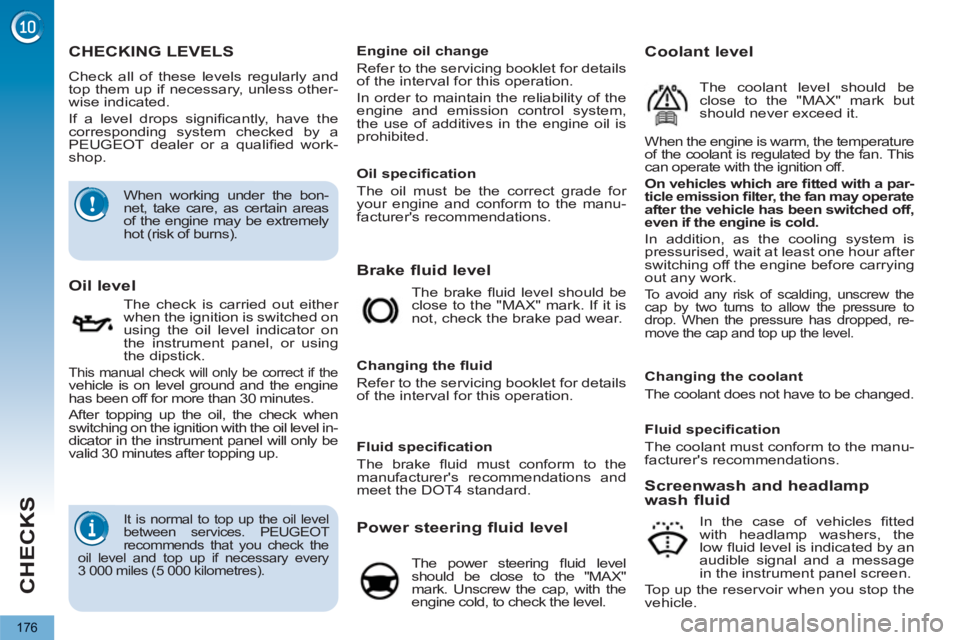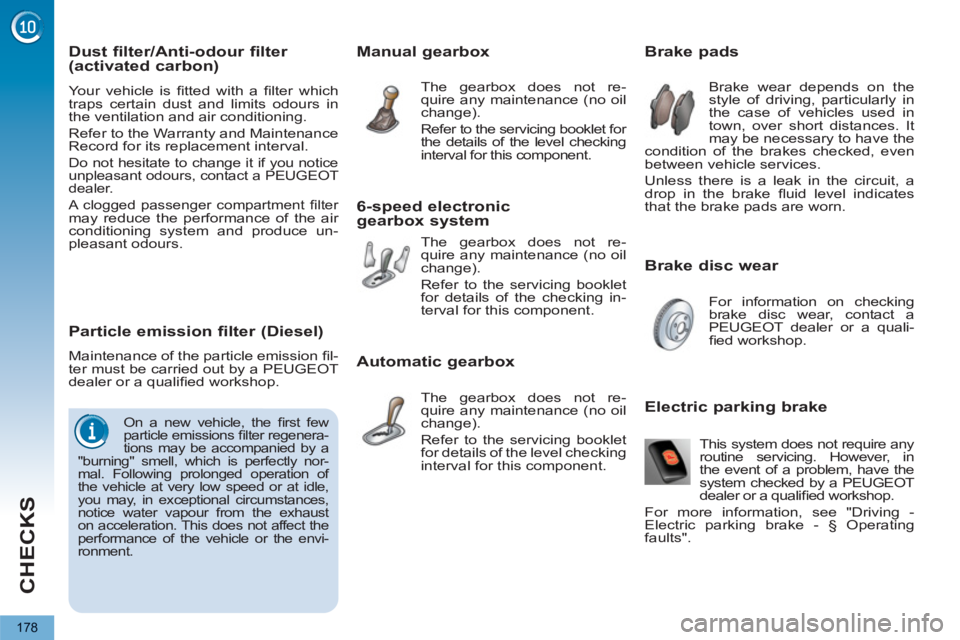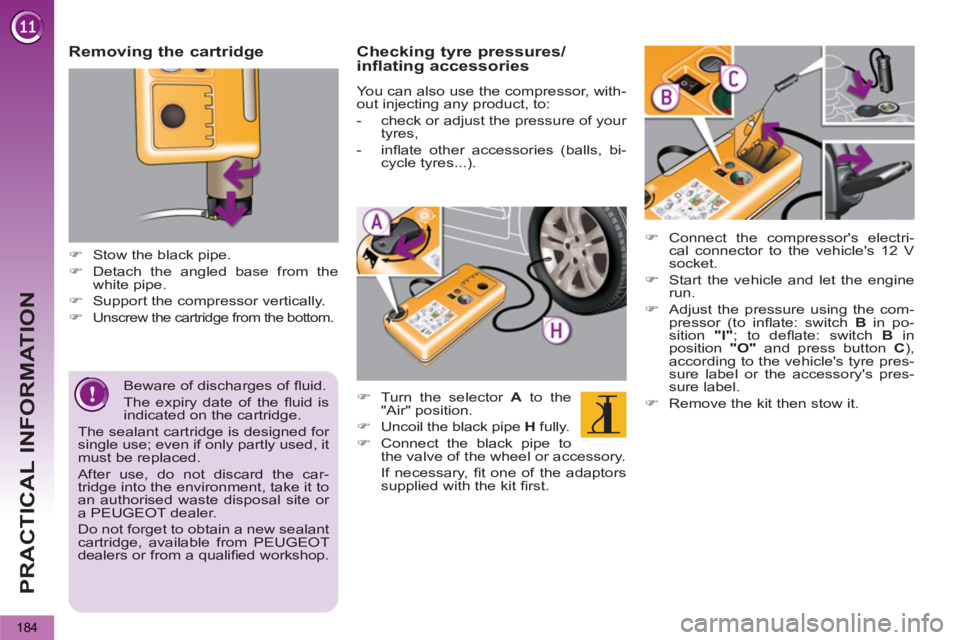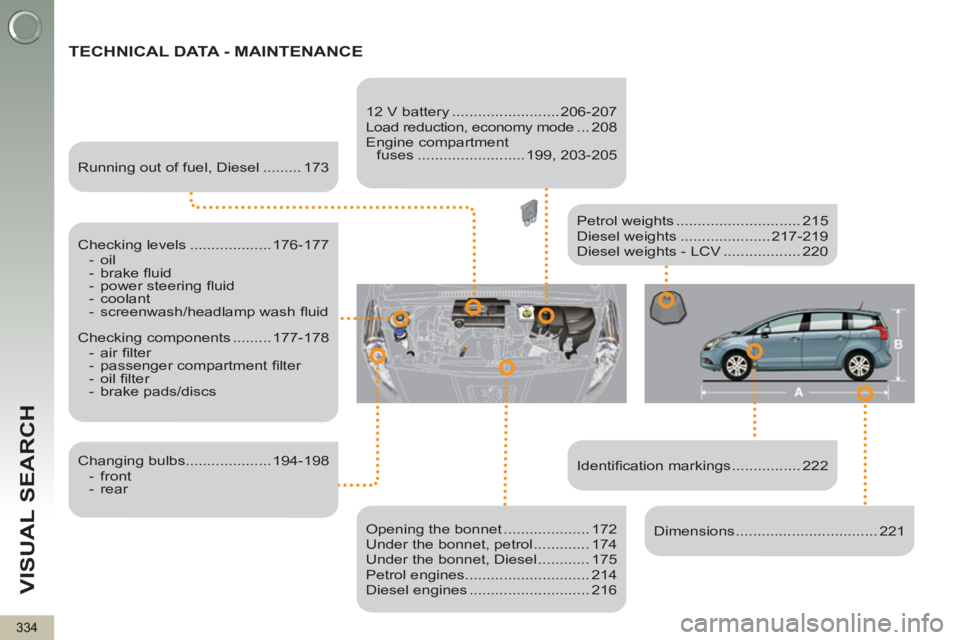2011 PEUGEOT 5008 checking oil
[x] Cancel search: checking oilPage 176 of 340

CHECKS
174
PETROL ENGINES
The various caps and covers allow access for checking the levels of the various fl uids and for replacing certain components.
1.
Power steering reservoir.
2.
Screenwash and headlamp wash
reservoir.
3.
Coolant reservoir.
4.
Brake fl uid reservoir.
5.
Battery/Fuses.
6.
Fusebox.
7.
Air fi lter.
8.
Engine oil dipstick.
9.
Engine oil fi ller cap.
Page 177 of 340

CHECKS
175
DIESEL ENGINES
The various caps and covers allow access for checking the levels of the various fl uids, for replacing certain components and
for priming the fuel system.
1.
Power steering reservoir.
2.
Screenwash and headlamp wash
reservoir.
3.
Coolant reservoir.
4.
Brake fl uid reservoir.
5.
Battery/Fuses.
6.
Fusebox.
7.
Air fi lter.
8.
Engine oil dipstick.
9.
Engine oil fi ller cap.
10.
Priming pump * .
11 .
Bleed screw * .
*
According to engine.
Page 178 of 340

CHECKS
176
CHECKING LEVELS
Check all of these levels regularly and
top them up if necessary, unless other-
wise indicated.
If a level drops signifi cantly, have the
corresponding system checked by a
PEUGEOT dealer or a qualifi ed work-
shop.
Brake fluid level
Oil level
The check is carried out either
when the ignition is switched on
using the oil level indicator on
the instrument panel, or using
the dipstick.
This manual check will only be correct if the vehicle is on level ground and the engine
has been off for more than 30 minutes.
After topping up the oil, the check when
switching on the ignition with the oil level in-
dicator in the instrument panel will only be
valid 30 minutes after topping up. The brake fl uid level should be
close to the "MAX" mark. If it is
not, check the brake pad wear.
Changing the fl uid
Refer to the servicing booklet for details
of the interval for this operation.
Power steering fluid level
The power steering fl uid level
should be close to the "MAX"
mark. Unscrew the cap, with the
engine cold, to check the level.
Screenwash and headlamp
wash fluid
In the case of vehicles fi tted
with headlamp washers, the
low fl uid level is indicated by an
audible signal and a message
in the instrument panel screen.
Top up the reservoir when you stop the
vehicle.
Engine oil change
Refer to the servicing booklet for details
of the interval for this operation.
In order to maintain the reliability of the
engine and emission control system,
the use of additives in the engine oil is
prohibited.
Fluid specifi cation
The brake fl uid must conform to the
manufacturer's recommendations and
meet the DOT4 standard.
When the engine is warm, the temperature
of the coolant is regulated by the fan. This
can operate with the ignition off.
On vehicles which are fi tted with a par-
ticle emission fi lter, the fan may operate
after the vehicle has been switched off,
even if the engine is cold.
In addition, as the cooling system is
pressurised, wait at least one hour after
switching off the engine before carrying
out any work.
To avoid any risk of scalding, unscrew the
cap by two turns to allow the pressure to
drop. When the pressure has dropped, re-
move the cap and top up the level.
Coolant level
The coolant level should be
close to the "MAX" mark but
should never exceed it.
When working under the bon-
net, take care, as certain areas
of the engine may be extremely
hot (risk of burns).
It is normal to top up the oil level
between services. PEUGEOT
recommends that you check the
oil level and top up if necessary every
3 000 miles (5 000 kilometres).
Oil specifi cation
The oil must be the correct grade for
your engine and conform to the manu-
facturer's recommendations.
Changing the coolant
The coolant does not have to be changed.
Fluid specifi cation
The coolant must conform to the manu-
facturer's recommendations.
Page 180 of 340

CHECKS
178
Brake disc wear
Brake pads
Brake wear depends on the
style of driving, particularly in
the case of vehicles used in
town, over short distances. It
may be necessary to have the
condition of the brakes checked, even
between vehicle services.
Unless there is a leak in the circuit, a
drop in the brake fl uid level indicates
that the brake pads are worn.
For information on checking
brake disc wear, contact a
PEUGEOT dealer or a quali-
fi ed workshop.
Manual gearbox
The gearbox does not re-
quire any maintenance (no oil
change).
Refer to the servicing booklet for
the details of the level checking
interval for this component.
6-speed electronic
gearbox system
The gearbox does not re-
quire any maintenance (no oil
change).
Refer to the servicing booklet
for details of the checking in-
terval for this component.
Automatic gearbox
The gearbox does not re-
quire any maintenance (no oil
change).
Refer to the servicing booklet
for details of the level checking
interval for this component.
This system does not require any
routine servicing. However, in
the event of a problem, have the
system checked by a PEUGEOT
dealer or a qualifi ed workshop.
For more information, see "Driving -
Electric parking brake - § Operating
faults".
Electric parking brake
Particle emission filter (Diesel)
Maintenance of the particle emission fi l-
ter must be carried out by a PEUGEOT
dealer or a qualifi ed workshop.
On a new vehicle, the fi rst few
particle emissions fi lter regenera-
tions may be accompanied by a
"burning" smell, which is perfectly nor-
mal. Following prolonged operation of
the vehicle at very low speed or at idle,
you may, in exceptional circumstances,
notice water vapour from the exhaust
on acceleration. This does not affect the
performance of the vehicle or the envi-
ronment.
Dust filter/Anti-odour filter
(activated carbon)
Your vehicle is fi tted with a fi lter which
traps certain dust and limits odours in
the ventilation and air conditioning.
Refer to the Warranty and Maintenance
Record for its replacement interval.
Do not hesitate to change it if you notice
unpleasant odours, contact a PEUGEOT
dealer.
A clogged passenger compartment fi lter may reduce the performance of the air
conditioning system and produce un-
pleasant odours.
Page 186 of 340

PRACTICAL INFORMATION
184
Beware of discharges of fl uid.
The expiry date of the fl uid is
indicated on the cartridge.
The sealant cartridge is designed for
single use; even if only partly used, it
must be replaced.
After use, do not discard the car-
tridge into the environment, take it to
an authorised waste disposal site or
a PEUGEOT dealer.
Do not forget to obtain a new sealant
cartridge, available from PEUGEOT
dealers or from a qualifi ed workshop.
Removing the cartridge
�)
Stow the black pipe.
�)
Detach the angled base from the
white pipe.
�)
Support the compressor vertically.
�)
Unscrew the cartridge from the bottom.
Checking tyre pressures/
inflating accessories
You can also use the compressor, with-
out injecting any product, to:
- check or adjust the pressure of your
tyres,
- infl ate other accessories (balls, bi-
cycle tyres...).
�)
Turn the selector A
to the
"Air" position.
�)
Uncoil the black pipe H
fully.
�)
Connect the black pipe to
the valve of the wheel or accessory.
If necessary, fi t one of the adaptors
supplied with the kit fi rst.
�)
Connect the compressor's electri-
cal connector to the vehicle's 12 V
socket.
�)
Start the vehicle and let the engine
run.
�)
Adjust the pressure using the com-
pressor (to infl ate: switch B
in po-
sition "I"
; to defl ate: switch B
in
position "O"
and press button C
),
according to the vehicle's tyre pres-
sure label or the accessory's pres-
sure label.
�)
Remove the kit then stow it.
Page 327 of 340

ALPHABETICAL INDEX
325
Accessories ...........................213
Accessory socket,
12 volt ...102, 104, 109, 110, 114
Access to
the 3rd row ............................71
Adjusting headlamps .........94, 95
Adjusting head
restraints .........................67, 69
Adjusting seat belt
height ..........................132, 133
Adjusting the steering
wheel ....................................75
Airbags ....................................36
Airbags, curtain..............138, 139
Airbags, front .................136, 139
Airbags, lateral...............138, 139
Air conditioning ........................25
Air conditioning,
digital ..............................59, 62
Air conditioning,
manual ............................59, 60
Air fi lter ..................................177
Air fl ow .....................................25
Air vents...................................58
Alarm .......................................81
Anti-pinch.........................83, 108
Anti-theft ..................................78
Armrest, rear .......................... 110
Assistance call .......................224
Audible warning .....................128
Audio/video sockets...............254
Audio streaming
(Bluetooth) ..........................315
Automatic illumination
of headlamps ..................91, 94
Automatic operation
of hazard warning lamps .....128
Automatic rain sensitive
windscreen wipers ..........96, 98
Auxiliary socket..............290, 312
Auxiliary sockets ............254, 310Battery ...........................177, 206
Battery, charging ....................206
Battery, remote control ......79, 80
Blind for panoramic sunroof ....108
Blinds ..................................... 115
Bluetooth (hands-free) ...255-257,
291, 292, 313
Bluetooth
(telephone) ...255-257, 291, 292
Bonnet ...................................172
Bonnet stay............................172
Boot .........................................87
Boot lamp ...................... 101, 115
Brake discs ............................178
Brake lamps...........................197
Brake pads ............................178
Brakes ...................................178Checks...........174, 175, 177, 178
Child lock ...............................127
Children .................120, 124, 125
Child seats ............................ 116
Child seats,
conventional ................ 118, 120
Closing the boot.................77, 87
Closing the doors...............77, 85
Cold climate screen ...............212
Colour screen,
retractable .................49, 51, 53
Concertina boards ... 72, 109, 110
Connectors,
audio ...103, 104, 290, 310, 312
Control for panoramic
sunroof blind .......................108
Coolant level ....................37, 176
Coolant temperature
indicator ................................37
Courtesy lamps........................99
Courtesy mirror ......................103
Cruise control ........................154
Cup holder ............. 102, 109, 110
AB
Capacity, fuel tank ...................89
CD MP3 .........................289, 309
Central locking ...................77, 86
Centre console ......................104
Changing a bulb ....194, 197, 198
Changing a fuse ....................199
Changing a wheel ..........188, 190
Changing a wiper
blade .............................98, 208
Changing
the date ...............260, 294, 317
Changing the remote
control battery .......................79
Changing the time ...260, 294, 317
Checking levels .............176, 177
Checking the engine
oil level ..................................40
Checking tyre pressures
(using the kit) ......................179
C
Date
(setting) .......260, 294, 316, 317
Daytime running
lamps ....................93, 194, 196
Deactivating ESP ...................131
Deactivating the passenger
airbag ..................................136
Deadlocking .............................77
Defrosting ..........................60, 61
Demisting.................................60
Dials and gauges .....................27
Diesel additive level ...............177
Dimensions ............................221
Dipped beam ...........91, 194, 195
Dipstick ............................40, 176
D
Page 336 of 340

VISUAL SEARCH
334
TECHNICAL DATA - MAINTENANCE
Identifi cation markings ................ 222
Petrol weights ............................. 215
Diesel weights ..................... 217-219
Diesel weights - LCV .................. 220
Running out of fuel, Diesel ......... 173
Checking levels ................... 176-177
- oil
- brake fl uid
- power steering fl uid
- coolant
- screenwash/headlamp wash fl uid
Checking components ......... 177-178
- air fi lter
- passenger compartment fi lter
- oil fi lter
- brake pads/discs
Changing bulbs.................... 194-198
- front
- rear
12 V battery ......................... 206-207
Load reduction, economy mode ...208
Engine compartment
fuses ......................... 199, 203-205
Opening the bonnet .................... 172
Under the bonnet, petrol ............. 174
Under the bonnet, Diesel ............ 175
Petrol engines............................. 214
Diesel engines ............................ 216
Dimensions ................................. 221